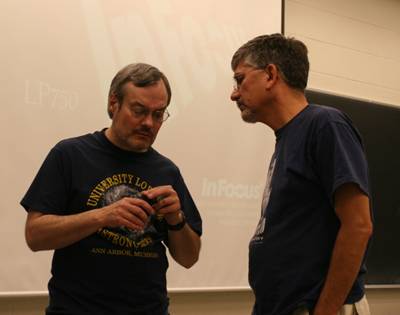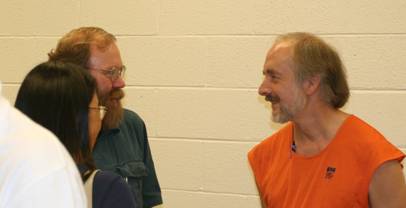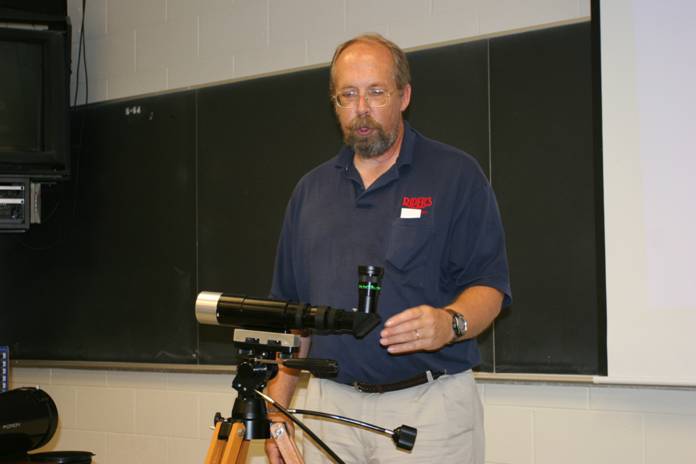


On the 15th of July, at the regular club meeting, John Kirchhoff, of the Livonia Rider’s Hobby Shop, talked to the attending Lowbrows about some of the latest products that are available to amateur astronomers. John gives this talk every year, and a large number of Lowbrows look forward to it because they can closely examine the latest offerings from various manufacturers. They also get the benefit of John’s personal opinion of the products, and since John is also a dedicated observer and often uses the products himself, his opinion is worth listening to.
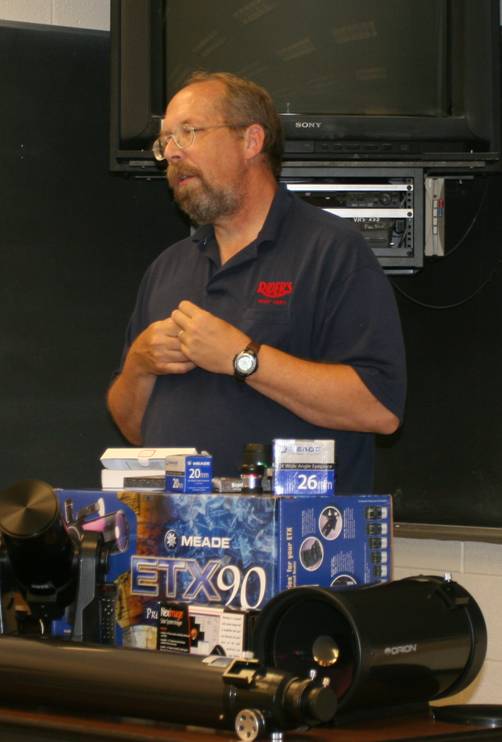
John brought a wide range of products, discussed their fine points, and passed many of them around the room for closer examination. If that weren’t enough, he followed up his demonstration with a talk about his personal experiences in high resolution planetary imaging. This last part provided the Lowbrows with some amazing images of the moon and planets, all taken from John’s backyard, using techniques which he is constantly improving upon. His pictures were so impressive that we asked him, and he agreed, to give the Lowbrows a more detailed account of his methods in the near future. We’re looking forward to that article, but for those who missed the meeting, what follows here are some of the highlights of his product demonstrations.
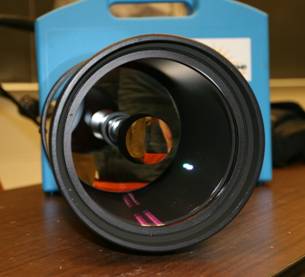
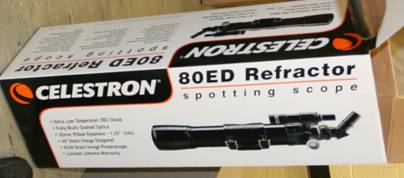
John’s telescopes were represented by an Orion 150mm Maksutov optical tube assembly and a Celestron 80mm ED refractor. John says the optics in the Celestron are apparently the same optics as are in the Orion 80mm ED refractor, both of them being manufactured by the Chinese company Synta. The Celestron had a price tag of $399.99, and the Maksutov, $649.00.
Maksutovs and small refractors have the advantage of being extremely portable, and have usually proven to have good quality optics. (See “A Tale of Two Telescopes” in Reflections, October, 2004). These scopes are expected to continue that tradition. John said that the Orion 5” Maksutov was very popular, but Orion had received some requests for a scope with more aperture; hence the 150mm.
John also brought a new ETX scope which featured Meade’s new LNT module, or Level North Technology. This is a feature of the ETX Premier series, and the technology is pretty exciting. This ETX retails for $749.00.
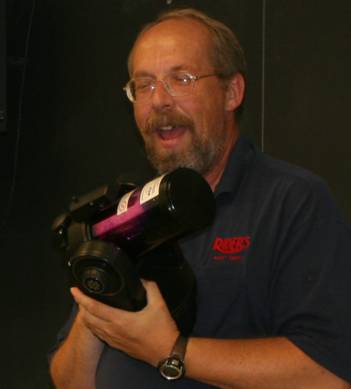
Eyepieces seem to be a product that everyone likes. Perhaps it’s because the price of an eyepiece, unlike the price of an entire scope, falls into that range where a person can buy it as an impulse purchase, or as a gift to themselves, without feeling guilty about stealing the food from one’s children’s mouths, or the shoes from their feet. (Eyepieces can just be fun. The author recently got a chance to look through a multi-element eyepiece from China that had anti-reflection coatings on only the top and bottom surfaces, and the memory of the myriad internal reflections has often warmed his heart; confirming as it does his opinion of the caveat emptor aspect of Chinese marketing. And while the author may find the selling of inferior goods amusing - He recently laughed and laughed, all the way to the ER, after breaking his ankle - that is exactly what John is trying to prevent by previewing his products in front of a group.)
For whatever the reason, the variety of eyepieces is large and is growing larger. John brought three lines of eyepieces with him.
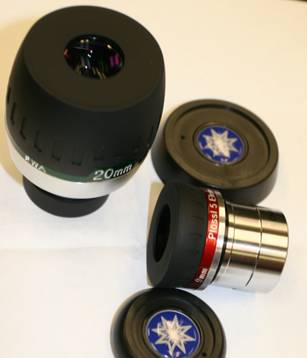
The first set were from Meade’s 5000-Series of plossl eyepieces. John brought a 9mm (eyepiece, that is; the crowd was friendly) for $89.00, and a 20mm for $200.00. These eyepieces have five or six elements in them, and have a 60 degree apparent field of view.
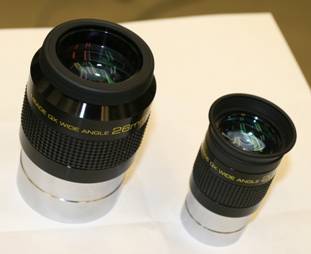
The second set of eyepieces, pictured above, are from Meade’s QX series of wide angle eyepieces. (The source of the name QX is a mystery, but it is rumored that Meade didn’t want to confuse any of their products with the QNX real time operating system, which is currently trying to quietly take over the world). The 26mm and the 20mm pictured above sell for $89 and $79, respectively, are multicoated, and have five elements and a 70 degree apparent field of view.
Not pictured is a third series of wide angle eyepieces by Orion. They are the “Stratus” series, and are interesting because they cost $119.00 for any focal length. John said that they are similar to Vixen’s eyepieces. You can get more information about these from Mark Rotenberg at Rider’s.
John also had a couple of Oxygen III filters; a 2” diameter for $139, and an 1 1/4” diameter fileter for $89. These are brand new, are at introductory prices, and cost much less than equivalent OIII filters available elsewhere. John did caution his audience that these filters work best on telescopes of 8” aperture and greater, because of the large amount of light they remove from the image. It should be noted that these filters also remove sky fog, since very few streetlights are illuminated by triply ionized oxygen, and as a result can often make a nebula visible that wouldn’t be otherwise.
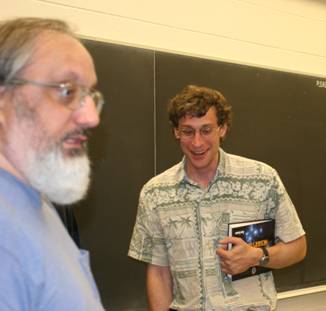
(For examples of David’s work, see the wide field astrophotos and the deep sky astrophotos sections of this web site).
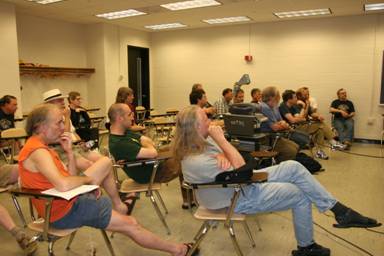
While on the topic of filters, John also brought along a small Solar Scope with a Coronado filter and a Teleview 10mm eyepiece. I believe he said the price of the ensemble was $4500, but I may be wrong. John is hoping to pick up the high-end Coronado line of solar filters, and if he can, it will be a remarkable addition to Rider’s offerings. The Sun takes on completely new dimensions when viewed through one of these filters, coupled to a really good refractor of, say, 100mm aperture. The filter that the author used could shift its passband to view dopplered material on the sun.
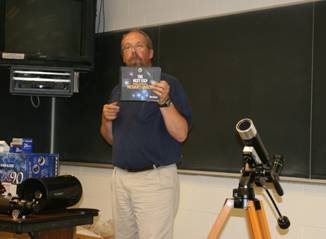
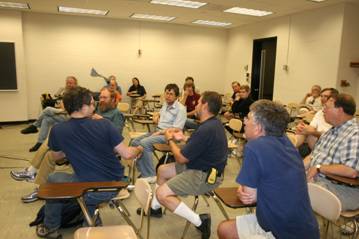
John brought two books with him, which he highly recommends to observers. The first was the Messier book “The Next Step - Finding and Viewing Messier’s Objects” by Ken Graun. John is holding a copy of it in the above picture, but it somehow found its way into David Tucker’s hands before the night was over.

The second book was what John calls “the Moon book.” It is actually “The Atlas of the Moon,” by Antonin Rukler, and it is recently back in print by Sky and Telescope Publishing Co. John says it has outstanding moon charts. John would be in a position to know this. During his talk on high resolution astrophotography of the moon and planets from your backyard, John showed the Lowbrows photos he had taken with detail of 1/2 mile at 240,000 miles. (That’s better than a half arc second, which is the theoretical resolution of a 13” telescope).
Other items that John brought included a dew heater, a Meade Deep Sky Imager CCD camera (Mark Rotenberg says these are very popular, and when I visited his store recently, someone came in and bought one off the shelf), and a green Laser Pointer for $99. These green laser pointers are remarkable, because they use an IR laser diode to pump another diode, which emits at 1064nm, and is frequency doubled to 532nm, all on an optical bench inside a pen. So when you are taking out low flying aircraft with one, don’t drop it.
All in all, everyone had a great time at the “Goodies Show,” and we are looking forward to John’s show next year.
